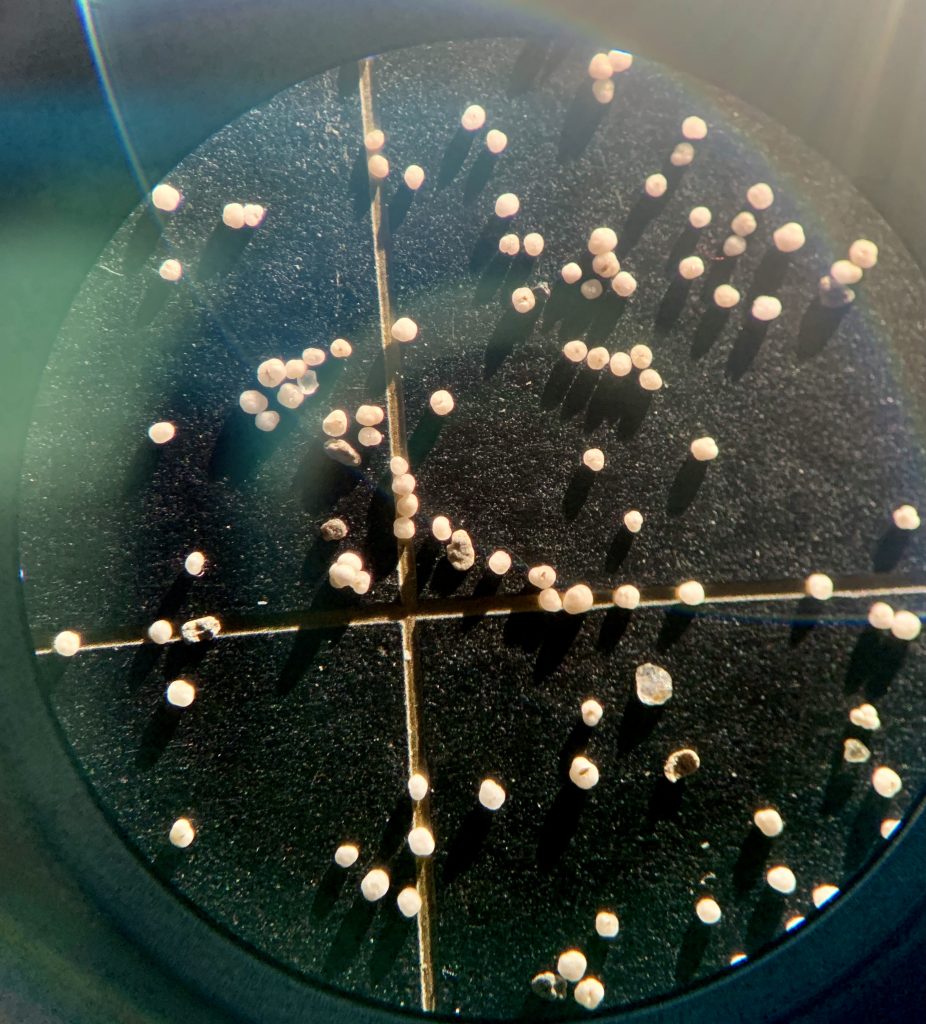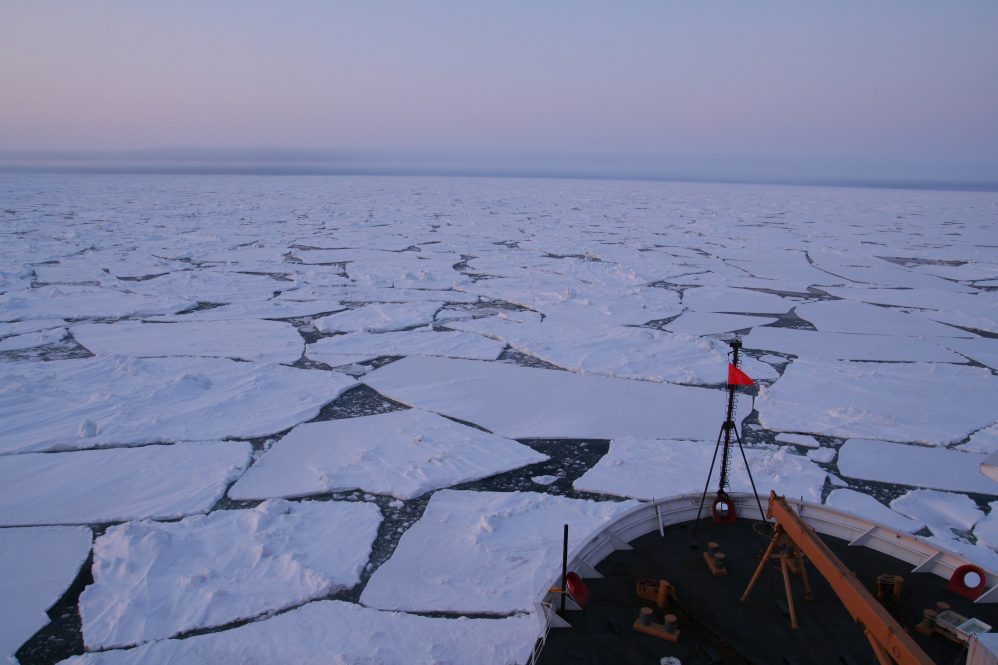As the North Pole, the Arctic Ocean, and surrounding Arctic land warm rapidly, scientists are racing to understand the warming’s effects on Arctic ecosystems. With shrinking sea ice, more light reaches the surface of the Arctic Ocean. Some have predicted that this will lead to more plankton, which in turn would support fish and other animals.
Not so fast, says a team of scientists, including UConn Associate Professor of Marine Sciences Julie Granger and led by researchers from Princeton University and the Max Planck Institute for Chemistry.
They point to nitrogen, a vital nutrient. The researchers used fossilized plankton to study the history of sources and supply rates of nitrogen to the western and central open Arctic Ocean. Their work, detailed in a paper in the current issue of the journal Nature Geoscience, suggests that under a global warming regime, these open Arctic waters will experience more intense nitrogen limitation, likely preventing a rise in productivity.
“Looking at the Arctic Ocean from space, it’s difficult to see water at all, as much of the Arctic Ocean is covered by a layer of sea ice,” says lead author Jesse Farmer, a postdoctoral research associate in the Department of Geosciences at Princeton University who is also a visiting postdoctoral fellow at the Max Planck Institute for Chemistry in Mainz, Germany. This sea ice naturally expands during winters and contracts during summers. In recent decades, however, global warming has caused a rapid decline in summer sea ice coverage, with summer ice cover now roughly half that of 1979.

As sea ice melts, photosynthesizing plankton that form the base of Arctic food webs should benefit from the greater light availability. “But there’s a catch,” says Granger. “These plankton also need nutrients to grow, and nutrients are only abundant deeper in the Arctic Ocean, just beyond the reach of the plankton.” Whether plankton can acquire these nutrients depends on how strictly the upper ocean is “stratified,” or separated into layers. The upper 200 meters (660 feet) of the ocean consists of distinct layers of water with different densities, determined by their temperature and saltiness.
New research shows how the supply of nitrogen to the Arctic has changed since the last ice age, which reveals the history of Arctic Ocean stratification. Using sediment cores from the western and central Arctic Ocean, the researchers measured the isotopic composition of organic nitrogen trapped in the limestone fossils of foraminifera (plankton that grew in surface waters, then died and sank to the sea floor). Their measurements reveal how the proportions of Atlantic- and Pacific-derived nitrogen changed over time, while also tracking changes in the degree of nitrogen limitation of plankton at the surface.
Where the Oceans Meet: Pacific Waters Float Above Saltier, Denser Atlantic Waters
The Arctic Ocean is the meeting place of two great oceans: the Pacific and the Atlantic. In the western Arctic, Pacific Ocean waters flow northward across the shallow Bering Strait that separates Alaska from Siberia. Arriving in the Arctic Ocean, the relatively fresh Pacific water flows over saltier water from the Atlantic. As a result, the upper water column of the western Arctic is dominated by Pacific-sourced nitrogen and is strongly stratified.
However, this was not always the case. “During the last ice age, when the growth of ice sheets lowered global sea level, the Bering Strait didn’t exist,” said Princeton Professor of Geological and Geophysical Science Daniel Sigman. At that time, the Bering Strait was replaced by the Bering Land Bridge, a land connection between Asia and North America that allowed for the migration of humans into the Americas. Without the Bering Strait, the Arctic would only have Atlantic water, and the nitrogen data confirm this.
When the ice age ended 11,500 years ago, as ice sheets melted and sea level rose, the data show the sudden appearance of Pacific nitrogen in the open western Arctic basin, dramatic evidence of the opening of the Bering Strait.
This was just the first of the surprises. Analyzing the data, Farmer also realized that, prior to the opening of the Bering Strait, the Arctic had not been strongly stratified as it is today. Only with opening the Bering Strait did the western Arctic become strongly stratified, as reflected by the onset of nitrogen limitation of plankton in the surface waters.
Heading eastward away from the Bering Strait, the Pacific-sourced water is diluted away, so that the modern central and eastern Arctic are dominated by Atlantic water and relatively weak stratification. Here, the researchers found that nitrogen limitation and density stratification varied with climate. As in the western Arctic, stratification was weak during the last ice age, when climate was colder. After the ice age, central Arctic stratification strengthened, reaching a peak between about 10,000 and 6,000 years ago, a period of naturally warmer Arctic summer temperatures called the “Holocene Thermal Maximum.” Since that time, central Arctic stratification has weakened, allowing enough deep nitrogen to reach surface waters to exceed the requirements of plankton.
Global warming is quickly returning the Arctic to the climate of the Holocene Thermal Maximum. As this warming continues, some scientists have predicted that reduced ice cover would enhance the productivity of Arctic plankton by increasing the amount of sunlight reaching the ocean. The new historical information acquired by Farmer and his colleagues suggests that such a change is unlikely for the open basin waters of the western and central Arctic. The western Arctic will remain strongly stratified due to persistent inflow of Pacific water through the Bering Strait, while the warming will strengthen stratification in the central Arctic. In both of these open ocean regions, slow nitrogen supply is likely to limit plankton productivity, the researchers concluded.
“Ongoing environmental change in the Arctic is alarmingly rapid,” Granger says. “Having notions of what will transpire in the future can inform strategies for adaptation of human communities, and for assessing the vulnerability of the food web. Contrary to current notions, this work suggest that continued warming and ice retreat will not result in a more productive central Arctic outside of the continental shelves.”
“Arctic Ocean stratification set by sea level and freshwater inputs since the last ice age,” by Jesse R. Farmer, Daniel M. Sigman, Julie Granger, Ona M. Underwood, François Fripiat, Thomas M. Cronin, Alfredo Martínez-García and Gerald H. Haug, appears in the current issue of Nature Geoscience (DOI: 10.1038/s41561-021-00789-y). The research was supported by the Max Planck Society, the Tuttle Fund of the Department of Geosciences of Princeton University, the Grand Challenges Program of the Princeton Environmental Institute, ExxonMobil through the Andlinger Center for Energy and the Environment of Princeton University, the U.S. National Science Foundation (OCE-1535002) and the USGS Land Change Program.



